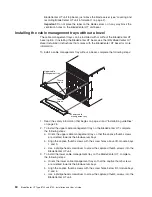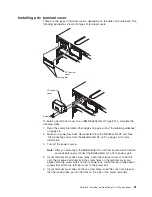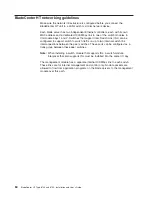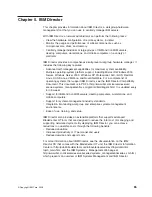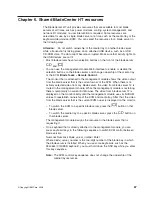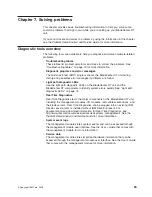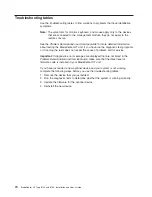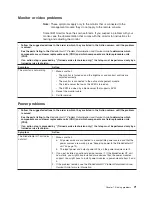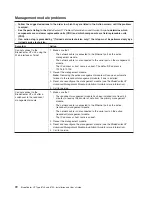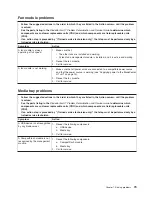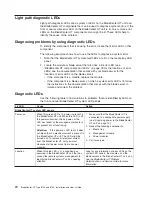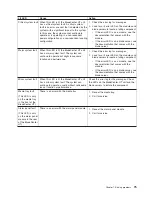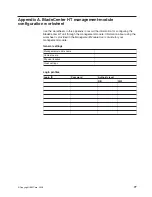
Chapter
4.
Configuration
and
networking
guidelines
The
BladeCenter
HT
components
are
configured
and
managed
through
a
management
module.
You
can
configure
the
management
module
and
the
BladeCenter
HT
unit
components
through
a
local
or
remote
connection
and
management-module
user
interfaces
or
other
system
management
tools.
See
your
management-module
documentation
for
instructions
for
configuring
the
BladeCenter
HT
unit.
Configuring
the
BladeCenter
HT
unit
General
configuration
of
the
BladeCenter
HT
unit
and
installed
components
is
performed
through
the
management
module.
See
the
BladeCenter
HT
Management
Module
User’s
Guide
and
the
BladeCenter
HT
Management
Module
Command-Line
Interface
Reference
Guide
for
your
management
module
for
information
and
instructions.
Some
devices
in
the
BladeCenter
HT
unit,
such
as
I/O
modules
and
blade
servers,
might
also
require
additional
configuration.
See
the
documentation
that
comes
with
each
device
for
information
and
instructions.
Configuring
the
management
module
All
management
modules
are
preconfigured
with
the
same
static
IP
address.
You
can
use
the
management
module
user
interface
to
assign
a
new
static
IP
address.
To
establish
connectivity,
the
management
module
attempts
to
use
Dynamic
Host
Configuration
Protocol
(DHCP)
to
acquire
its
initial
IP
address
for
the
management-module
Ethernet
port.
If
DHCP
is
not
installed
or
is
enabled
and
fails,
the
management
module
uses
the
static
IP
address.
Use
the
management
module
to
configure
other
BladeCenter
HT
component
settings,
such
as
user
accounts,
DHCP,
or
Wake
on
LAN.
See
the
documentation
for
your
management
module
for
instructions.
Configuring
I/O
modules
You
must
install
and
configure
at
least
one
external
(in-band)
port
on
an
Ethernet
switch
module
in
I/O-module
bay
1
or
2
to
communicate
with
the
Ethernet
controllers
that
are
integrated
in
each
blade
server.
See
the
documentation
for
your
management
module
for
information
about
configuring
external
ports
on
I/O
modules.
For
I/O-device
settings,
see
the
documentation
that
comes
with
your
I/O
device.
Note:
If
a
pass-thru
module
is
installed
in
I/O-module
bay
1
or
2,
you
must
configure
the
external
network
switch
to
which
the
pass-thru
module
is
connected;
see
the
documentation
that
comes
with
the
external
network
switch.
Configuring
blade
servers
To
achieve
blade
server
redundancy,
you
must
configure
the
Ethernet
controllers
in
one
or
more
blade
servers
for
failover.
When
failover
occurs
on
a
blade
server,
the
secondary
Ethernet
controller
takes
over
network
communications,
using
the
I/O
module
that
is
associated
with
that
controller.
Install
a
pair
of
Ethernet
switches
in
I/O-module
bays
1
and
2,
and
then
configure
them
and
your
network
infrastructure
so
that
they
can
direct
traffic
to
the
same
destinations.
You
can
also
install
a
pass-thru
module
that
is
connected
to
an
external
Ethernet
switch
in
either
or
both
of
these
I/O-module
bays.
See
the
documentation
that
comes
with
your
blade
server
and
operating
system
for
instructions.
©
Copyright
IBM
Corp.
2008
63
Summary of Contents for 87401RU
Page 3: ...BladeCenter HT Type 8740 and 8750 Installation and User s Guide...
Page 8: ...vi BladeCenter HT Type 8740 and 8750 Installation and User s Guide...
Page 82: ...66 BladeCenter HT Type 8740 and 8750 Installation and User s Guide...
Page 92: ...76 BladeCenter HT Type 8740 and 8750 Installation and User s Guide...
Page 108: ...92 BladeCenter HT Type 8740 and 8750 Installation and User s Guide...
Page 109: ......
Page 110: ...Part Number 44R5188 Printed in USA 1P P N 44R5188...












